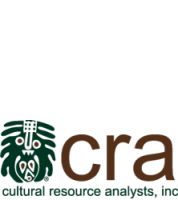
02 Mar CRA Spotlight: Andrew P. Bradbury
CRA prides itself in the talented staff and the expertise that they bring to every project we do. No matter if it’s a small survey or large data recovery project, multiple people lend their expertise to ensure each project is completed to the best of our abilities. This team approach has served CRA well since first forming in 1983. A number of our people have been with the company for over 15 years. The commitment to quality work and the opportunities provided by CRA and our projects is part of the reason for the longevity of our staff. In a series of blog posts, we will introduce you to some of our staff and what they bring to the company. In this post we will introduce you to Andrew Bradbury who joined the CRA team in August of 1994. Andrew started out as a staff archaeologist mostly running phase I surveys. He was soon running larger phase II testing and phase III data recovery projects. He is currently one of CRA’s principal investigators and also specializes in lithic analysis.
 From the beginning, it has been CRA’s philosophy that CRM archaeology can make contributions to the field of archaeology and no project, and particularly a data recovery project, is completed until the important findings of the project have been shared with the archaeological community as a whole. Andrew is no exception and exemplifies this philosophy. As of February 2022, Andrew has 60 publications (and 3 more in press) in various archaeological journals and edited volumes (co-editor on one volume). These journals include Lithic Technology, North American Archaeologist, Midcontinential Journal of Archaeology, Southeastern Archaeology, and the Journal of Archaeological Method and Theory. These publications can be generally separated into those that report on work that CRA has conducted and those that are research based (see selected list below). Of these publications, 27 were either based on work conducted through CRA or where data collected during a CRA project were employed. It is also noteworthy that on 19 of the publications, at least one other CRA employee was a co-author. Our team approach goes beyond just the CRM project at hand!
From the beginning, it has been CRA’s philosophy that CRM archaeology can make contributions to the field of archaeology and no project, and particularly a data recovery project, is completed until the important findings of the project have been shared with the archaeological community as a whole. Andrew is no exception and exemplifies this philosophy. As of February 2022, Andrew has 60 publications (and 3 more in press) in various archaeological journals and edited volumes (co-editor on one volume). These journals include Lithic Technology, North American Archaeologist, Midcontinential Journal of Archaeology, Southeastern Archaeology, and the Journal of Archaeological Method and Theory. These publications can be generally separated into those that report on work that CRA has conducted and those that are research based (see selected list below). Of these publications, 27 were either based on work conducted through CRA or where data collected during a CRA project were employed. It is also noteworthy that on 19 of the publications, at least one other CRA employee was a co-author. Our team approach goes beyond just the CRM project at hand!
In addition to the various projects that Andrew is associated with at CRA, he has continued his own research outside of the CRM world. He has often collaborated with Philip Carr (University of South Alabama) on a variety of lithic analysis related publications. This work has focused on method and theory in lithic analysis. In his everyday work at CRA, Andrew has analyzed lithic artifacts from projects in Kentucky, Tennessee, Missouri, Illinois, Virginia, West Virginia, Indiana, Mississippi, and North Carolina. Rather than just settle for conducting these analyses using the same methods each time, he has strived to push the limits of how lithic artifacts can inform on the past and the people who made and used these artifacts. Very early on in his career, Andrew realized that old methods of analysis may not be as reliable as suggested and there were possibly better ways to analyze lithic artifacts that were more reliable and could provide more detailed information about the past. This is part of the inspiration for his continued research with Philip Carr on analytical methods. His research has included an extensive experimental program. Much of the experimental work has focused on flintknapping experiments and determining how best to analyze flake debris from archaeological sites. This ties back into his work at CRA as newer methods that he has helped develop are employed in analyzing lithic artifacts recovered from various CRA projects. The outside research, in conjunction with his work at CRA, has made for a successful career both within the CRM world and academic world.
Selected publications relating to CRA projects:
Bradbury, A. P.
2017 Late Middle Archaic Settlement Systems in West-Central Illinois. North American Archaeologist, 38(1):24-62.
2016 Late Archaic Occupations at Kayford Gap (46KA358), Kanawha County, West Virginia. Journal of Middle Atlantic Archaeology 32:27-50.
2013 Radiocarbon Chronology for Archaic Period Sites within the Avenue of the Saints Project, Northeast Missouri. Missouri Archaeologist 74:31-41.
2011 Middle Archaic Site Structure at the Berhorst Site (23LE174), Lewis County, Missouri. Missouri Archaeologist 72:39-75.
2010 Bipolar Reduction Experiments and the Examination of Middle Archaic Bipolar Technologies in West-Central Illinois. North American Archaeologist 31(1):67-116.
2007 Lithic Analysis of an Early Archaic Knapping Area. Midcontinental Journal of Archaeology 32(1):47-70.
2006 The Organization of Lithic Technology and the Bifurcate Occupation of the Hart Site (15La183), Lawrence County, Kentucky. North American Archaeologist 27(1):1-24.
2004 Early Archaic Biface Manufacture at 15Cu31. In Current Archaeological Research in Kentucky, Volume 7. Edited by C. D. Hockensmith and K. C. Carstens, pp. 1-18. Kentucky Heritage Council, Frankfort, Kentucky.
2001 Modern or Prehistoric: Experiments in Distinguishing Between Culturally and Mechanically Produced Chipped Stone Artifacts. North American Archaeologist 22(3):231-258.
Bradbury, A. P. and P. D. Bundy
2014 The Early Archaic Hardin Barbed Component at the Baxter Lake Site, Lewis County, Missouri, Missouri Archaeologist, 75:98-114.
Bradbury, A. P. and D. Randall Cooper
- Middle Woodland Blades from the Carskadon Site, Lewis County, Missouri. Missouri Archaeological Society Quarterly, 4:12-18.
2014 Middle Woodland Micro-tools from the Carskadon Site, Lewis County, Missouri. Missouri Archaeological Society Quarterly 1:18-20.
Bradbury, A. P. and S. D. Creasman
2008 Spatial Analysis and Site Structure of the Early Archaic Occupation of the Hart Site (15La183), Lawrence County, Kentucky. Southeastern Archaeology 27(1):31-44.
Bradbury, A. P., S. D. Creasman, and B. G. DelCastello
2011 Site Structure Analysis of a late Middle Archaic Upland site in Morgan County, Illinois. North American Archaeologist 32(4):327-367.
Bradbury, A. P. and R. L. Herndon
2014 A Shovel Testing Survey of the Canton Site (15Tr1), Trigg County, Kentucky. Journal of Kentucky Archaeology, 3(1-2):2-31. Available online at: http://campus.murraystate.edu/academic/j_ky_arch/Journal_Kentucky_Archaeology/Vol_3_No_1-2/Bradbury-Herndon-Canton_site.htm
Herndon, R. L. and A. P. Bradbury
2018 Refining Woodland Period Chronology and Interactions in Northeastern Missouri: Contributions from the Avenue of the Saints Project. Midcontinental Journal of Archaeology 43(1):1-22.
2014 A Tinsley Hill Phase Mississippian Occupation at the Confluence of the Tennessee and Ohio Rivers. Journal of Kentucky Archaeology 3(1-2):49-71. Available online at: http://campus.murraystate.edu/academic/j_ky_arch/Journal_Kentucky_Archaeology/Vol_3_No_1-2/Herndon_Bradbury_Chestnut_Lake.htm
Herndon, R. L., A. P. Bradbury, N. H. Lopinot, B. G. DelCastello, and G. S. Powell
2014 The Artesian Branch Site: Late Woodland Occupations in the Mississippi Floodplain of Northeastern Missouri. Illinois Archaeologist 26:56-84.
Herndon, R. L., A. P. Bradbury, and N. H. Lopinot
2016 The Carskadon Site: a bluff-base Middle Woodland settlement within the Mississippi floodplain of northeast Missouri. The Missouri Archaeologist, 77:1-33.
Kerr, J. P. and A. P. Bradbury
1998 Paleo-Indian and Archaic Settlement at Kentucky Lake. Tennessee Anthropologist 23(1-2):1-20.
Kerr, J. P., A. P. Bradbury, and G. L. Day
2004 Excavations at 15CU27: A Rockshelter in South-Central Kentucky. In Current Archaeological Research in Kentucky, Volume 7. Edited by C. D. Hockensmith and K. C. Carstens, pp. 35-54. Kentucky Heritage Council, Frankfort, Kentucky.
Selected publications based on outside research that include CRA employees:
Bradbury, A. P., P. J. Carr, and D. R. Cooper
2008 Raw Material and Retouched Flakes. In Lithic Technologies: Measures of Production, Use, and Curation, edited by William Andrefsky, Jr., pp. 233-254. Cambridge University Press.
Bradbury, A. P., D. R. Cooper, and R. L. Herndon
2012 Points on Points: A Response to Pollack et al. Journal of Kentucky Archaeology 1(2):65-82. Available online at: http://campus.murraystate.edu/academic/j_ky_arch/Journal_Kentucky_Archaeology/Vol_1_No_2/Bradbury_points_on_pointsl.htm
2011 Kentucky’s Small Triangular Subtypes: Old Theories and New Data., Journal of Kentucky Archaeology 1(1):2-24. Available online at: http://campus.murraystate.edu/academic/j_ky_arch/Journal_Kentucky_Archaeology/Vol_1_No_1/Bradbury_Cooper_Herndon_Small_Triangular.htm.
Bradbury, A. P., J. L. Allgood, J. M. Anderson, M. D. Richmond, and D. L. Rotman
2008 Exploring Surface Collected Data with Spatial Analysis Methods. North American Archaeologist 29(1):13-36.
Creasman, S. D., A. P. Bradbury and J. P. Kerr
2000 The Archaeological Potential of Small Sites. In Current Archaeological Research in Kentucky: Volume 6. Edited by David Pollack and Kristen Gremillion, pp. 25-46. Kentucky Heritage Council, Frankfort, Kentucky.
Selected publications based on outside research:
Bradbury, A. P.
2021 Benton Phase biface production for exchange: analysis of a lithic reduction area at site 40HO13, Southeastern Archaeology, DOI: 10.1080/0734578X.2021.1907725
Bradbury, A. P. and P. J. Carr
2014 Non-metric Continuum-Based Flake Analysis. Lithic Technology 39(1):1-19.
2012 Examining the Role of Blade and Bipolar Technologies in the Organization of Early Archaic Lithic Technology. In Contemporary Lithic Analysis in the Southeast: Problems, Solutions, and Interpretations, edited by P.J. Carr, A. P. Bradbury, and S. E. Price, pp. 79-95 University of Alabama Press.
2009 Hits and misses when throwing stones at Mass Analysis. Journal of Archaeological Science. 36(12): 2788-2796.
2009 Early Archaic Raw Material Use Patterns in Tennessee. Tennessee Anthropologist 4(1-2):94-116.
2004 Combining Aggregate and Individual Methods of Flake Debris Analysis: Aggregate Trend Analysis. North American Archaeologist 25(1):65-90.
2003 A Method for Quantifying Size and Shape of Hafted Bifaces. In Lithic Analysis at the Millennium, Edited by N. Moloney and M. J. Shott, pp. 173-188. Institute of London, University College, London.
1999 Examining Stage and Continuum Models of Flake Debris Analysis: An Experimental Approach. Journal of Archaeological Science 26(1):105-116.
1995 Flake Typologies and Alternative Approaches: An Experimental Assessment. Lithic Technology 20(2):100-116.
Carr, P. J. and A. P. Bradbury
2018 Stone Tool Life Meets Everyday Life. In Investigating the Ordinary: Everyday Matters in Southeast Archaeology, edited by Sarah E. Price and Philip J. Carr, pp. 124-141. University of Florida Press.
2018 Evaluating Descriptions of Clovis Migration and Lifeways by Applying an Organization of Technology Model. In The Eastern Fluted Point Tradition, Volume II, edited by Joseph A. M. Gingerich, pp. 267-277, The University of Utah Press.
2011 Learning From Lithics: A Perspective on the Foundation and Future of the Organization of Technology. Special Issue: Reduction Sequence, Chaîne Opératoire, and Other Methods: The Epistemologies of Different Approaches to Lithic Analysis, edited by Gilbert B. Tostevin. PaleoAnthropology 2011:305-319.
2010 Flake Debris and Flintknapping Experimentation. In Designing Experimental Research in Archaeology: Examining Technology through Production and Use, edited by Jeffrey R. Ferguson, pp. 71-92. University Press of Colorado.
2004 Exploring Mass Analysis, Screens, and Attributes. In Aggregate Analyses in Chipped Stone, edited by C. T. Hall and M. L. Larson, pp. 21-44. University of Utah Press.
2001 Flake Debris Analysis, Levels of Production and the Organization of Technology. In Lithic Debitage Analysis: Context, Form, Meaning, edited by W. Andrefsky, Jr., pp 126-146. The University of Utah Press, Salt Lake City.
2000 Contemporary Lithic Analysis and Southeastern Archaeology. Southeastern Archaeology, 19(2):120-134.
Carr, P. J., A. P. Bradbury, and S.E. Price, editors
2012 Contemporary Lithic Analysis in the Southeast: Problems, Solutions, and Interpretations. University of Alabama Press.
Engelbrecht, William Andrew P. Bradbury, and Roderick B. Salisbury
2021 Patterning in a large sample of retouched unifacial tools. Journal of Archaeological Science: Reports 40(B):1-15.
Shott, M. J, A. P. Bradbury, P. J. Carr, and G. H. Odell
2000 Flake Size from Platform Attributes: Predictive and Empirical Approaches. Journal of Archaeological Science 27(10): 877-894.



